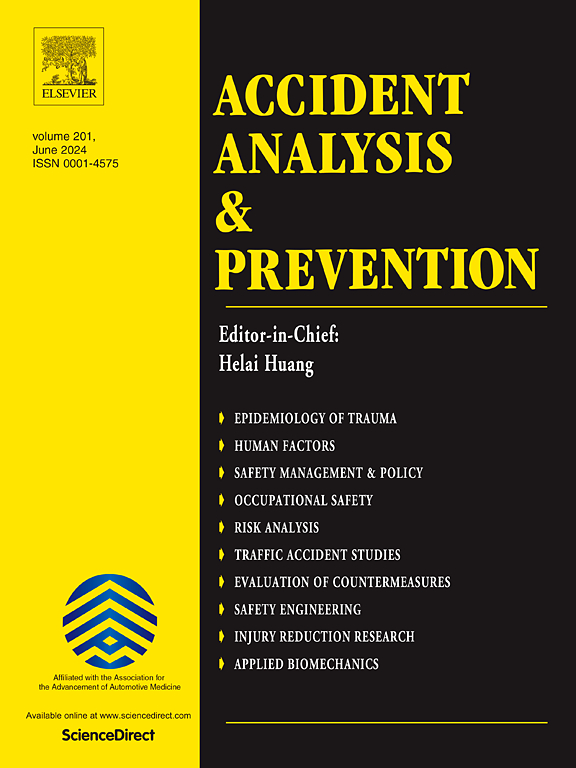A hybrid data mining framework to investigate roadway departure crashes on rural two-lane Highways: Applying Fast and Frugal Tree with Association Rules Mining
IF 5.7
1区 工程技术
Q1 ERGONOMICS
引用次数: 0
Abstract
The complexity of factors contributing to roadway departure (RwD) crashes on rural highways necessitate advanced analytical approaches to enhance traffic safety. This study presents a hybrid data mining framework that combines the Fast and Frugal Tree (FFT) and Association Rules Mining (ARM) algorithms to identify the patterns of RwD crashes on rural 2-lane highways in Louisiana state. The research is focused on addressing two critical research questions (RQ), RQ1: Which variable features contribute to the fatal-severe RwD crashes? RQ2: Focusing on the identified top factors contributing to fatal-severe RwD crashes, how co-occurrence of different crash-contributing factors increase the likelihood of RwD crashes? For the analysis, this research team collected crash data from the Louisiana Department of Transportation and Development, encompassing a total of 22,406 unique RwD crashes on rural 2-lane highways. In the first stage (addressing RQ1), the FFT model identified the top variable features contributing to fatal-severe RwD crashes, including no use of seatbelts, alcohol-impaired driver condition, male gender, dark-no-streetlight, older drivers (>64 years), 12 am – 6 am, light truck, and so on. In the second stage (addressing RQ2), based on the factors identified by FFT, ARM explored how these factors interact and associate, revealing intricate drivers’ behavioral patterns related to RwD crashes. This comprehensive analysis uncovers not only the individual impact of these factors but also their combined effects, offering a deeper understanding of the dynamics of RwD crashes. This research contributes valuable insights into evidence-based, data-driven strategies to reduce the frequency and severity of RwD crashes on rural highways, advancing traffic safety initiatives and improving safety on rural 2-lane roadways.
基于混合数据挖掘框架的农村双车道高速公路偏离事故研究:应用快速节约树和关联规则挖掘
农村高速公路道路偏离事故因素的复杂性需要先进的分析方法来提高交通安全。本研究提出了一个混合数据挖掘框架,该框架结合了快速节俭树(FFT)和关联规则挖掘(ARM)算法,以识别路易斯安那州农村两车道高速公路上的RwD碰撞模式。该研究的重点是解决两个关键的研究问题(RQ), RQ1:哪些变量特征导致了致命的严重RwD碰撞?RQ2:关注已确定的导致致命严重RwD事故的主要因素,不同事故因素的共同发生如何增加RwD事故的可能性?为了进行分析,该研究小组收集了路易斯安那州交通与发展部的碰撞数据,其中包括22,406起在农村双车道高速公路上发生的独特RwD碰撞。在第一阶段(解决RQ1), FFT模型确定了导致致命严重RwD碰撞的最重要变量特征,包括不使用安全带、酒后驾驶状态、男性、黑暗无路灯、年龄较大的司机(64岁)、凌晨12点至6点、轻型卡车等。在第二阶段(解决RQ2),基于FFT确定的因素,ARM探索了这些因素如何相互作用和关联,揭示了与RwD碰撞相关的复杂驾驶员行为模式。这项综合分析不仅揭示了这些因素的单独影响,还揭示了它们的综合影响,从而更深入地了解RwD碰撞的动态。这项研究为以证据为基础的数据驱动战略提供了宝贵的见解,以减少农村公路上RwD碰撞的频率和严重程度,推进交通安全举措,提高农村双车道公路的安全性。
本文章由计算机程序翻译,如有差异,请以英文原文为准。
求助全文
约1分钟内获得全文
求助全文
来源期刊

Accident; analysis and prevention
Multiple-
CiteScore
11.90
自引率
16.90%
发文量
264
审稿时长
48 days
期刊介绍:
Accident Analysis & Prevention provides wide coverage of the general areas relating to accidental injury and damage, including the pre-injury and immediate post-injury phases. Published papers deal with medical, legal, economic, educational, behavioral, theoretical or empirical aspects of transportation accidents, as well as with accidents at other sites. Selected topics within the scope of the Journal may include: studies of human, environmental and vehicular factors influencing the occurrence, type and severity of accidents and injury; the design, implementation and evaluation of countermeasures; biomechanics of impact and human tolerance limits to injury; modelling and statistical analysis of accident data; policy, planning and decision-making in safety.
 求助内容:
求助内容: 应助结果提醒方式:
应助结果提醒方式:


